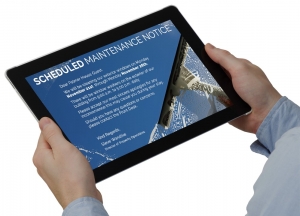
By Neil Schubert
The way guests are choosing to communicate with hotels is changing, but the fundamental importance of one-to-one engagement remains the same
Remember the days of NCR cash registers and metal keys with slots behind the desk? It still brings a smile to my face, just like an old episode of Gunsmoke. It was a time when communication with guests was face-to-face. Like many of my industry colleagues, it was the personal interactions with people while working at the front desk that got me hooked on the hotel business.
In the good ‘ole days, people were generally friendly and excited about traveling. The was no pre-arrival check-in online; people were happy to register at the front desk. Children were entertained by a swimming pool and bouncing on beds. And weary road warriors were thankful to just get to a hotel room with clean sheets and hot water. It’s this type of joyful anticipation and excitement that hoteliers need to cultivate today along every step of the guest journey.
By definition, hospitality is “the friendly and generous reception of guests, visitors or strangers.” It’s a mantra that I have built my career on, and it’s the core principle on which each property should be built — even if guests’ communication expectations have changed dramatically. There is no denying that the pandemic accelerated the use of self-service tools, and there are fewer direct customer engagements now than ever before. Much of the change is generational, with younger travelers opting more for mobile engagement. This is not to say that the front office is an endangered species; it’s not. Although some brands have opted to remove this touch point altogether, most still keep it in some form as a point-of-contact hub for people who expect it and prefer to communicate “the old-fashioned way.”
Embracing Digital Diversity
Like it or not, digital guest engagement is here to stay, and adopting a digital communication strategy is critical to business survival. Communication with guests has its own flavors of diversity. I myself will still walk up to that front desk agent if the line is not too long, while others prefer a skip-the-desk check-in experience. When considering your digital guest engagement strategy, it’s important to think through all the various contact points for one- and two-way communication.
Ask yourself what guests will want to know about your hotel and what’s happening in it and around it. Wayfinding is often effectively managed with digital signage products (but sometimes not). Branded apps are getting more robust with content and feature functionality but they still suffer from lack of meaningful engagement. Text messaging is becoming common for two-way engagement. TV platforms are becoming more effective for one-way communications. And despite what many may think, we still have hotel guestroom telephones. Publishing QR codes instead of print collateral is also a growing trend.
The communication platform making the most traction today is the interactive guestroom tablet.
Here’s why: Hardware costs for these devices have dropped considerably in the past few years. There has been a longstanding desire to eliminate print collateral in the room and keep content fresh and current. Although we have tried for years to deliver room service with interactive television screens, the TV is simply not a good two-way interactive device. And guests are choosing to ignore the message-waiting light on the phone. So, how do you best reach a customer that is checked in? Forget sliding a piece of paper under their door . . . message them instead via tablet where that communication is sure to get through.
Talk, Text & Tablet
“The Guest Journey” is always changing from brand to brand, pre-arrival to post-departure. Too often we assume that communication needs are met once the guest has checked in because the guest can pick up the phone or stop by the front desk; and we are there to address their needs. For Boomers like me, that’s great. But for those who wish to reach my Millennial son and Gen Z daughter, you better have an effective digital engagement strategy. Don’t allow guest communication to be the weakest link in the stay experience.
The most effective means to ensure intent to return is to uncover any unexpressed dissatisfaction and meet guests’ needs before they have checked out unhappy. But that is far more difficult to accomplish as fewer guests approach your staff. You won’t know they were unhappy until they post their trip advisor review or submit their brand survey.
Did you know . . . for every customer complaint there are 26 other unhappy customers who have remained silent . . . 96% of unhappy customers don’t complain, however, 91% of those will simply leave and never come back . . . and, it takes 12 positive experiences to make up for one unresolved negative experience.

According to the 2023 Lodging Technology Study, 95% of hotel operators say two-way messaging with guests is currently offered or it is planned to be added in the coming year. It’s quite clear that hotel operators are realizing this pain point and searching for effective tools.
A hotel guestroom tablet is truly the only effective, unobtrusive tool to achieve a 100% reach to hotel guests and it can be used as a platform to drive better customer engagement with the brand apps and text messaging channels. The tablet can also replace most peripheral in-room equipment, like the phone, TV remote, and clock/radio. And it can be used to push surveys, optimize room cleaning, and promote revenue-generating late check-out.
If you want to text guests, fine. Talk to them, please. Let the brand app do what it does best. But if you really want to reach them, consider the value that a guestroom tablet will deliver.

